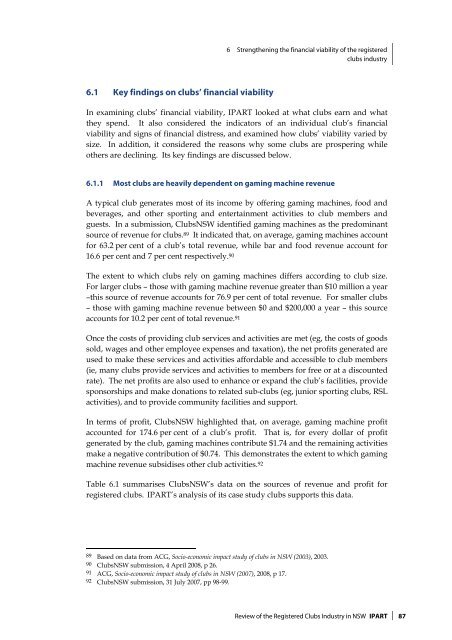Review of the Registered Clubs Industry in NSW - Clubs NSW
Review of the Registered Clubs Industry in NSW - Clubs NSW
Review of the Registered Clubs Industry in NSW - Clubs NSW
Create successful ePaper yourself
Turn your PDF publications into a flip-book with our unique Google optimized e-Paper software.
6 Streng<strong>the</strong>n<strong>in</strong>g <strong>the</strong> f<strong>in</strong>ancial viability <strong>of</strong> <strong>the</strong> registered<br />
clubs <strong>in</strong>dustry<br />
6.1 Key f<strong>in</strong>d<strong>in</strong>gs on clubs’ f<strong>in</strong>ancial viability<br />
In exam<strong>in</strong><strong>in</strong>g clubs’ f<strong>in</strong>ancial viability, IPART looked at what clubs earn and what<br />
<strong>the</strong>y spend. It also considered <strong>the</strong> <strong>in</strong>dicators <strong>of</strong> an <strong>in</strong>dividual club’s f<strong>in</strong>ancial<br />
viability and signs <strong>of</strong> f<strong>in</strong>ancial distress, and exam<strong>in</strong>ed how clubs’ viability varied by<br />
size. In addition, it considered <strong>the</strong> reasons why some clubs are prosper<strong>in</strong>g while<br />
o<strong>the</strong>rs are decl<strong>in</strong><strong>in</strong>g. Its key f<strong>in</strong>d<strong>in</strong>gs are discussed below.<br />
6.1.1 Most clubs are heavily dependent on gam<strong>in</strong>g mach<strong>in</strong>e revenue<br />
A typical club generates most <strong>of</strong> its <strong>in</strong>come by <strong>of</strong>fer<strong>in</strong>g gam<strong>in</strong>g mach<strong>in</strong>es, food and<br />
beverages, and o<strong>the</strong>r sport<strong>in</strong>g and enterta<strong>in</strong>ment activities to club members and<br />
guests. In a submission, <strong>Clubs</strong><strong>NSW</strong> identified gam<strong>in</strong>g mach<strong>in</strong>es as <strong>the</strong> predom<strong>in</strong>ant<br />
source <strong>of</strong> revenue for clubs. 89 It <strong>in</strong>dicated that, on average, gam<strong>in</strong>g mach<strong>in</strong>es account<br />
for 63.2 per cent <strong>of</strong> a club’s total revenue, while bar and food revenue account for<br />
16.6 per cent and 7 per cent respectively. 90<br />
The extent to which clubs rely on gam<strong>in</strong>g mach<strong>in</strong>es differs accord<strong>in</strong>g to club size.<br />
For larger clubs – those with gam<strong>in</strong>g mach<strong>in</strong>e revenue greater than $10 million a year<br />
–this source <strong>of</strong> revenue accounts for 76.9 per cent <strong>of</strong> total revenue. For smaller clubs<br />
– those with gam<strong>in</strong>g mach<strong>in</strong>e revenue between $0 and $200,000 a year – this source<br />
accounts for 10.2 per cent <strong>of</strong> total revenue. 91<br />
Once <strong>the</strong> costs <strong>of</strong> provid<strong>in</strong>g club services and activities are met (eg, <strong>the</strong> costs <strong>of</strong> goods<br />
sold, wages and o<strong>the</strong>r employee expenses and taxation), <strong>the</strong> net pr<strong>of</strong>its generated are<br />
used to make <strong>the</strong>se services and activities affordable and accessible to club members<br />
(ie, many clubs provide services and activities to members for free or at a discounted<br />
rate). The net pr<strong>of</strong>its are also used to enhance or expand <strong>the</strong> club’s facilities, provide<br />
sponsorships and make donations to related sub-clubs (eg, junior sport<strong>in</strong>g clubs, RSL<br />
activities), and to provide community facilities and support.<br />
In terms <strong>of</strong> pr<strong>of</strong>it, <strong>Clubs</strong><strong>NSW</strong> highlighted that, on average, gam<strong>in</strong>g mach<strong>in</strong>e pr<strong>of</strong>it<br />
accounted for 174.6 per cent <strong>of</strong> a club’s pr<strong>of</strong>it. That is, for every dollar <strong>of</strong> pr<strong>of</strong>it<br />
generated by <strong>the</strong> club, gam<strong>in</strong>g mach<strong>in</strong>es contribute $1.74 and <strong>the</strong> rema<strong>in</strong><strong>in</strong>g activities<br />
make a negative contribution <strong>of</strong> $0.74. This demonstrates <strong>the</strong> extent to which gam<strong>in</strong>g<br />
mach<strong>in</strong>e revenue subsidises o<strong>the</strong>r club activities. 92<br />
Table 6.1 summarises <strong>Clubs</strong><strong>NSW</strong>’s data on <strong>the</strong> sources <strong>of</strong> revenue and pr<strong>of</strong>it for<br />
registered clubs. IPART’s analysis <strong>of</strong> its case study clubs supports this data.<br />
89 Based on data from ACG, Socio-economic impact study <strong>of</strong> clubs <strong>in</strong> <strong>NSW</strong> (2003), 2003.<br />
90 <strong>Clubs</strong><strong>NSW</strong> submission, 4 April 2008, p 26.<br />
91 ACG, Socio-economic impact study <strong>of</strong> clubs <strong>in</strong> <strong>NSW</strong> (2007), 2008, p 17.<br />
92 <strong>Clubs</strong><strong>NSW</strong> submission, 31 July 2007, pp 98-99.<br />
<strong>Review</strong> <strong>of</strong> <strong>the</strong> <strong>Registered</strong> <strong>Clubs</strong> <strong>Industry</strong> <strong>in</strong> <strong>NSW</strong> IPART 87
















